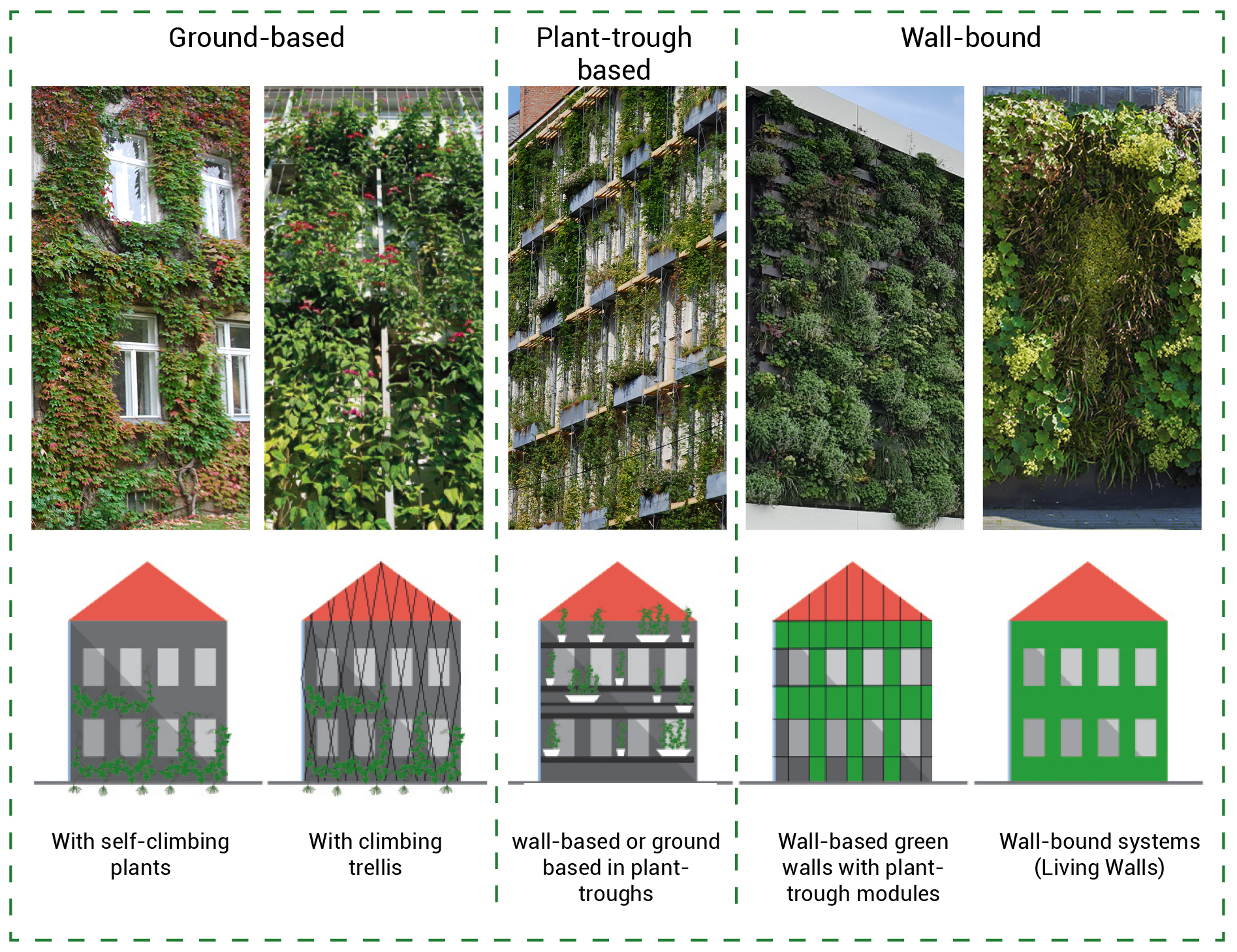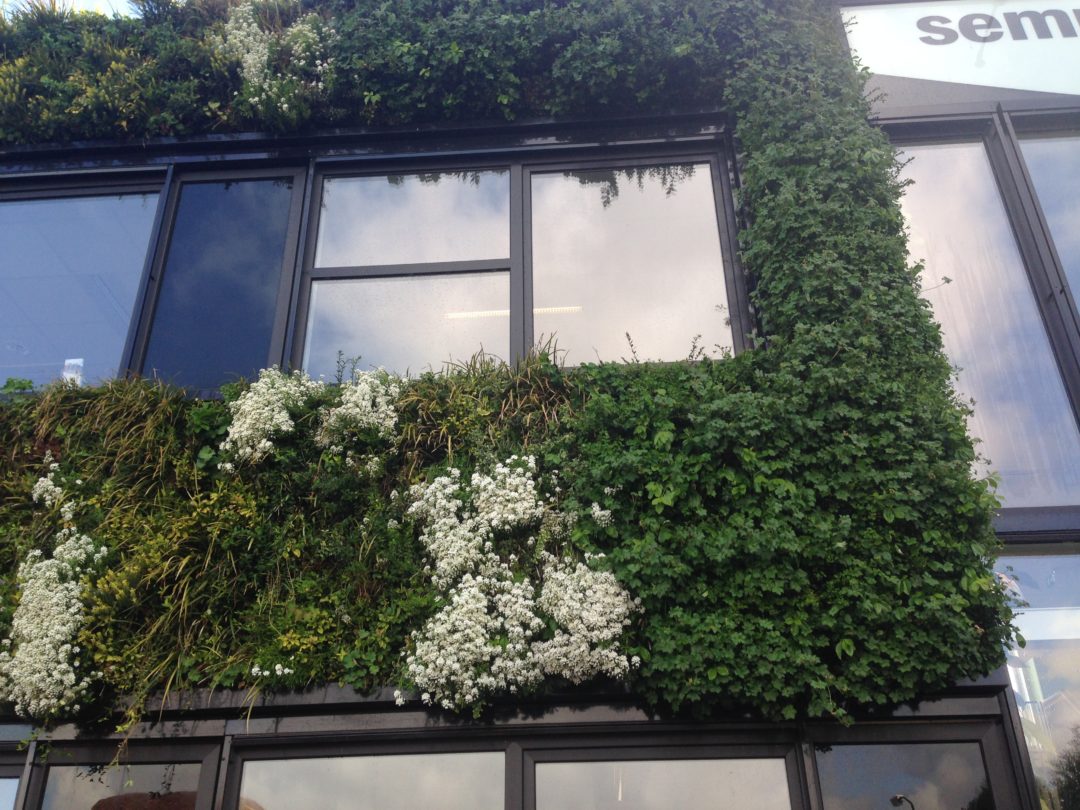Types of Green Walls

Soil-bound green walls: Climbing plants
Soil-bound green walls are planted in naturally grown soil. They allow only a greening to the maximum growth height of the climbing plant that is used. A sufficiently dimensioned planting pit has to be provided.
1. With climbing trellis
For this kind of green wall, climbing plants (winders, tendrils, etc.), which require a climbing aid / trellis, are used. Thus it is possible to green only partial areas of facades along the trellis and even to create patterns. A sufficient dimension of the climbing aid and a sufficient number of anchor points must be provided.
1.1. Stiff construction
The climbing aid is a stiff construction. It can be made from metal, wood or plastic. Stiff constructions are used for climbing plants, which have a strong growth in girth and/or lead to a high tense in constructions of steel ropes. Thus a sufficient dimension (diameter of tubes or rods) of the climbing aids has to be provided.
1.1.a. Planar
The climbing aid is made of a net-like construction, which allows a planar greening with climbing plants.
1.1b. Linear
Single linear climbing aids (for example rods made of steel or carbon fibre) allow the greening of partial areas of facades.
1.2. Flexible construction
Flexible climbing aids are for climbing plants with low growth in girth.
1.2a. Planar
The climbing aid is made of a net-like construction, which allows a planar greening with climbing plants.
1.2b. Linear
Single linear climbing aids (for
example steel ropes) allow the greening of partial areas of facades.
2. Without climbing trellis
For this kind of green wall only self-climbing plants, which do not need any climbing trellis, can be used. The facade has to be of an outstanding condition; otherwise it can be damaged by the weight of the adult climbing plants or the aerial rootlet (like for example ivy).
Living Wall Systems
The vegetation is planted directly at the façade. A connection to the ground is not needed.
1. All-over substrate Living Wall system
All over the Living Wall there is a continuous substrate body.
1.1. Plants in 90°
The vegetation is planted with the root bales in 90° to the façade.
1.1a. “Building kit” system
This kind of Living Wall is made of modular units, which are applied to scaffolding. Together they build up the façade greening.
1.1b. Overall System
This Living Wall system is made of only one component.
1.2. Plants in less than 90°
The vegetation is planted with the root bales in less than 90° to the façade.
1.2a. “Building kit” system
This kind of Living Wall is made of modular units, which are applied to scaffolding. Together they build up the façade greening.
1.2b. Overall System
This Living Wall system is only made of one component.
2. Subarea substrate Living Wall System
The substrate body of the Living Wall system is divided in different compartments or subareas.
2.1. Linear
The shape of the Living Wall System is made up by trays/cascades, which are linearly attached to the façade.
2.1a. Less than 50 cm gap
The gap between the façade and the trays/greening modules is less than 50 cm. For a complete greening suitable herbaceous plants have to be selected.
2.1b. More than 50 cm gap
The gap between the façade and the trays/greening modules is more than 50 cm. For a complete greening, suitable climbing plants or other high growing lignifying plants (hedges) have to be selected.
2.2. Selective greening
Trays, which are attached to the façade, can be used for a selective greening.
In this case, a completely green façade can only be achieved by means of climbing plants (with or without trellis). If the vegetation is made up by sedum, grass species, perennials or lignifying plants, only a small-area greening can be achieved.
Green Wall Benefits
Reduction of Urban Heat Island and improvement of urban microclimate
Green walls are recognized to have a positive effect on reducing the Urban Heat Island Effect. They have the ability to bind CO2 and to produce oxygen. The evaporation performance of the vegetation and the substrate increases the humidity and improves the urban microclimate. In summertime the heating of the building surfaces is reduced due to the shading by the plants. Green facades achieve a noticeable cooling effect and act as “near-natural air-conditioning systems”.
Water retention
As a consequence of climate change, intense rainfall events become more frequent. Green walls can reduce the surface runoff volumes. They can help to reduce flash floods and therefore relieve the sewage network. The additional capacity for water retention can help to cope with intense rainfall events in the future.
Thermal Performance
Green walls act as an additional part of the thermal insulation. They can buffer temperature-related peaks in summertime. Green walls have been shown to significantly reduce the need for air conditioning in summer and can provide a degree of insulation in winter. Depending on the type of building, the costs for cooling in summer and heating in winter can be considerably lowered.
Air Quality
Green walls contribute to the absorption of fine dust and air purification in urban areas. Airborne particles and pollutants are filtered from the atmosphere by the substrates and vegetation of green walls. Depending on the plant species and size of the leaves, the plants can hold large quantities of fine particles. Green walls have the ability of self-cleaning through leaf fall in autumn and thus represent the prototype of a “clean facade”.
Sound Insulation
The combination of plants, substrate and trapped layers of air within green wall systems can act as a sound insulation barrier. Sound waves are absorbed, reflected or deflected. The growing medium tends to block lower sound frequencies whilst the plants block higher frequencies.
Biodiversity
Green walls can provide important refuges for wildlife in urban areas. They offer a protected habitat for various insect and bird species. In urban areas it is necessary to provide a link between the different habitats by a dense network of small living spaces (so-called “step stones”). Green roof structures can for example be connected to the habitats on the ground by means of green walls.
Protection of Building Stock
A well-designed green wall is a natural protective shield against negative impacts and contributes to the prolongation of life of building stock. Climbing plants act like a green curtain, the leaves form a shed structure and protect the surface. The drainage effect of the roots helps to retain the foundations dry. Green walls have a temperature-balancing effect. They function as a thermal insulation. In addition, they provide protection against UV radiation, pollutants, dirt, and thereby inhibit the fatigue of materials. Green walls can be an effective, low-cost and low-maintenance facade protection against graffiti as well.
Upgrading of Building Stock
Green walls not only enhance the building, they can also submit a higher sales value of the building. Apartments with green facades are considered to be very popular and demanded on the real estate market.


